As opposed to saltwater fishes, freshwater fishes are calm and get adapted to new surroundings pretty easily. Moreover, most freshwater fishes are highly compatible with each other as tank mates which allows you to have a variety of fishes in your tank.
If you have been looking for some beautiful freshwater fishes to add some lovely colors to your aquarium, then you are not short of options.
In this post, we will take you through the top 18 colorful freshwater fishes that can brighten up your aquarium.
Male Betta

Bettas are one of the most intelligent fishes and make up an excellent choice for a pet. They can recognize the owner, and you can teach them some tricks as well.
Appearance: The famous Betta fish has spectacular-looking bright fins which come in a myriad of colors such as yellow, red, orange, blue, purple, white, and black.
Behavior: These fishes are territorial and can get aggressive towards other betas.
Compatibility: Male betta fishes should be kept in individual tanks or just as the only species among the whole community in an aquarium. Also, you should not put male and female betta fishes together. You can successfully keep male betta fish in a community aquarium that doesn’t have aggressive fishes.
Discus

The Discus fish originates from the Amazon River Basin and belongs to the family of Cichlids genus. As the fish is a little fragile and needs a lot of maintenance, it is ideal for aquarists who have some experience in fish keeping.
Appearance: Discus gets its name from the round disc-like shape. These fishes are famous for their vivid range of colours such as orange, brown, blue, pink, yellow and more. And, on top of the variation in colours, they also carry beautiful body marks that look like brain patterns. They grow to a maximum of six inches in length and have a lifespan of up to 10 years.
Behaviour: These fishes are affable and can live in harmony in a peaceful community.
Compatibility: Discus will shoal together with similarly sized fishes, but they may eat smaller fishes. So, make sure that the tank mates are not tiny enough to fit into their mouths.
German Blue Ram
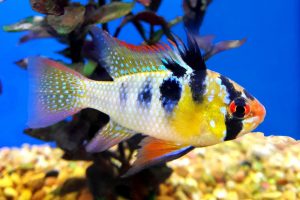
These are the most in-demand freshwater fishes. German Blue Ram is very calm and effortless to handle. Even though the fish is small in size but the flamboyant colours compensate for that. With the natural temperament, this fish doesn’t require a lot of maintenance. They grow up to three inches in size and have a lifespan of three years.
Appearance: The fish is brightly coloured with beautiful blue dots covering the fins, red patches near the eye and the belly, and dark vertical stripes on the body. You can find this species in yellow, red, purple, orange, and many more colours.
Behaviour: German Blue Ram likes to claim a territory mostly towards the bottom of the tank.
Compatibility: The fish is pretty amicable in nature and can settle with other fishes in an aquarium easily. It can be kept individually or in a pair as they tend to choose only one mate.
Flowerhorn Cichlid

This unique Cichlid species sticks out from the other fishes in the pack due to its bulging round head and exotic colours. Red coloured Flowerhorns are highly in demand among enthusiasts; however, one can find this fish in any possible colour. Due to their distinct patterns, these fishes can be exceptionally expensive. They can live up to 12 years and grow up to 11 inches in length. The fish needs a lot of space to swim and is territorial in nature.
Appearance: The fish is petal-shaped markings all over the body. It has a bulky body with various coloured patterns that differ from one another based on breeding. Also, the colour of the fish keeps changing until it reaches maturity.
Behaviour: Flowerhorn Cichlid is very feisty and can get aggressive with other tank mates.
Compatibility: Unfortunately, this fish cannot be kept with other fishes. It is recommended to have an individual tank for Flowerhorns.
Gourami

Originating from South and East Asia, Gourami is quite commonly found fishes in freshwater aquariums. You can find many varieties of Gourami which vary in their colours such as the Red Fire Dwarf Gourami, neon blue dwarf Gourami and the Branded Gourami. They are perfect for any aquarium as they are active, playful, entertaining and easy to care for.
Appearance: They come in various colours such as gold, blue, neon, and red. They have an oval-shaped body with huge dorsal and anal fins. The patterns differ in males and females. Gouramis also have a feeler barb on their pelvic fins to investigate their surroundings.
Behaviour: they are very active and swim at all levels in an aquarium. They can often get shy with other tank mates.
Compatibility: Males can get territorial which can be quickly dealt with by providing the right proportion of species and size in the tank.
Diamond Neon Tetra
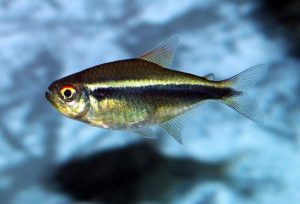
The Diamond Neon Tetra is an excellent choice for community aquariums. These are small shoaling fishes which you can keep in schools of 5-6 and more. They make a perfect choice for both beginners and experts.
Appearance: The fishes have distinctive blue stripes that run along the whole body and a stunning metallic diamond shape in their dorsal fins which keeps developing until the fishes reach maturity.
Behaviour: These fishes are very calm and tend to occupy the top and middle levels of the aquarium. They can get skittish at times, but if they are given sufficient space to hide, then they feel more comfortable. They get adapted to a new environment pretty quickly.
Compatibility: These fishes are highly compatible with angelfish, guppies, rummy-nose tetras, Cory catfish, cardinal tetras and black neon tetras. They are also cordial with adult dwarf shrimp and other large peaceful invertebrates.
Killifish

These fishes are famous for their tendency to jump and the variety of neon colours. There are more than 700 species of Killifish that are highly adaptable to any condition. Killifish require a lot of space to swim and adequate foliage in the tank.
Appearance: These vibrant fishes usually have a yellow and blue coloured body with orange stripes that run to their dorsal fins.
Behaviour: They are mostly peaceful and go well with small fishes in community tanks. However, males can get aggressive towards each other, so it is recommended to keep one male and several females in a tank. Generally, fish keepers choose to house them individually in tanks.
Compatibility: The compatibility with Killifish depends on their species, but they generally make good tank mates with other tropical fish species. Most often they can co-live with danios and tetras.
Endler’s Livebearer
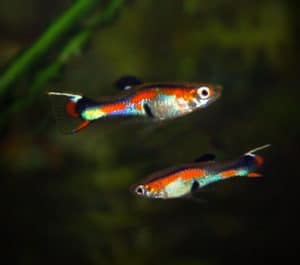
Even though this species is a favourite among enthusiasts, but still it is difficult to find it in average aquarium stores. They are small in size, but their unique and exotic colouring makes them stand out in an aquarium.
Appearance: These fishes are typically very colourful with vibrant neon patterns that come in yellow, green, blue and orange color. They are often compared to wild Guppies in their appearance.
Behaviour: They are very peaceful, adaptable and tolerant to changing tank conditions which makes them very easy to take care of. Generally, they tend to occupy the top level of the tank.
Compatibility: As these fishes need harder water as compared to other freshwater fishes; this should be taken into consideration when selecting the tank mates. Endlers can live peacefully with tetras, gouramis, cichlids and other small fishes. Make sure not to introduce, large fishes in the tank with Endlers as they can eat them up.
Fantail Guppy

These are attractive and inexpensive fishes that will add life to your aquarium with their diverse colours and distinct patterns. Their dorsal fin is large in comparison to the rest of the body, hence the name.
Appearance: There are more than twenty colour combinations for this species which include colours like blue, red, purple, yellow, green, teal and many more. Moreover, these colours are interspersed with silver and black which makes them even more alluring. They have eye-catching spots on their tail fins.
Behaviour: Guppies are peaceful and active when placed in a tank with similarly-sized fishes. They swim at the top of the water column
Compatibility: These are very friendly fishes that can live in harmony with platies and tetras. Guppies get along well with peaceful community fishes; however, as they are tiny, keep in mind not to house them with bigger fishes that can prey on them.
Peacock Cichlid
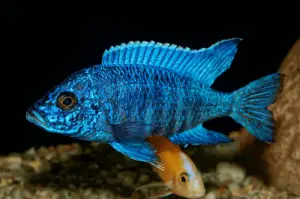
The Peacock Cichlid is a delight to watch and is immensely popular among both beginners and experienced aquarists.
Appearance: These fishes display a dozen of colour patterns. They have stunning vertical stripes on the body with lovely vivid colours like red, yellow, gold, orange, and blue. They can grow to around 6 inches in length and are characterised by a lateral line system.
Behaviour: These are bottom dwellers and tend to hover above the sand to hunt for food. They are active swimmers, and for that, they need a lot of space in a tank. Unlike the other Cichlid species, the Peacock Cichlid can live peacefully with other fishes.
Compatibility: Luckily, the Peacock Cichlids are not aggressive like other Cichlids and belong to the tamer members of the family. These peaceful fishes can get along and co-exist with any other freshwater fishes easily.
Boeseman’s Rainbowfish
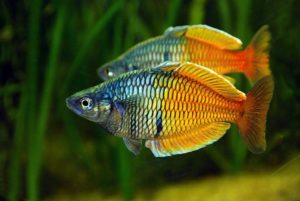
One of the most sought after freshwater fishes, Boeseman’s Rainbowfish is a native of Indonesia near Western New Guinea.
Appearance: Their colours are different from other species of Rainbowfish. The fishes have unique markings all over the body in dark lines. The frontal of the fish is purple or metallic silver/grey, and the rear half is in a vibrant shade of orange and red. The dorsal fins are coloured white on the outer edges. The colouration in this species can be further enhanced by a specific diet and adequate maintenance.
Behaviour: These fishes have a peaceful demeanour and are happy when they are schooled in a group of 6-8 with dense foliage within the aquarium. As they are schooling fishes, it is essential to keep an appropriate ratio of males to females to maintain peace among them.
Compatibility: They can happily co-live with other fishes of similar sizes such as cichlids, darios, catfish and other small breeds.
Cherry Barb

These uniquely coloured fishes are easygoing and makeup up the perfect choice for community tanks. The fish gets its name from the colour the male turns into when it is spawning. They fit correctly in tanks with vegetation which they use to hide when threatened.
Appearance: Male Cherry Barbs have a beautiful bright red colouring and females appear paler. These are small fishes with a slender, elongated body and can grow up to 2 inches in length. They also have a lateral stripe going all the way from head to tail. The females are slightly rounder around the stomach, and the males are slimmer in comparison.
Behaviour: These are active schooling fish and dwell in all the levels of the aquarium. They disperse around the tank; however, when threatened they will school tightly together. That is why it is essential to keep them in a group to prevent them from getting shy.
Compatibility: They can live with other peaceful community fishes. They should be kept in a group of six or more.
Oscars
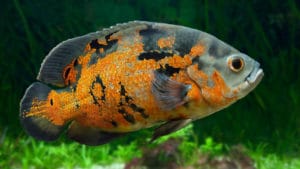
Oscars have a large size and beautiful colouring. They are considered to be very smart fishes that can be trained to do tricks.
Appearance: These fishes are small at the juvenile stage, but they can grow up to 13 inches in length. Oscars have an oval-shaped body with a big head and thick lips. Oscars are dark in colour with orange spots on their gills and back
Behaviour: These are territorial fishes and aren’t afraid to attack other fishes in the tank. They tend to dwell in the mid-levels of the aquarium and often head down to lower levels to search for food. However, their aggression can be controlled by setting up the tank correctly and choosing the right tank mates.
Compatibility: These are not community fishes; they should be housed in individual tanks as they can grow very fast. They may behave nicely with other tank mates when they are young, but adult fishes get aggressive. The possible tank mates can be large fish species such as green terror, jaguar cichlid, etc.
Zebra Danio

Zebra Danio belongs to the Family Cyprinidae. These are the perfect beginner fishes that are very easy to maintain.
Appearance: they have a slender and compressed body with a barbell on each lip. At maturity, these fishes can reach a length of three inches and can live up to four years. They have a pale yellow appearance with horizontal strips in steel-blue colour which fades into the fins.
Behaviour: They get along with their kind and most of the other species. Zebra Danios are schooling fishes and tend to get stressed if their numbers get too low.
Compatibility: These fishes are peaceful and are suitable for community aquariums. As these are shoaling fishes, they should be housed in a group of 6-8. In a large group, the fishes feel secure; otherwise, they feel nervous and never show their true nature. They can do well with fish species like tetras, small goldfish, catfish, small cichlids, barbs gouramis and other small freshwater fishes.
Electric Blue Hap

The Electric Blue Hap has been a favourite among aquarists because of its intense electric blue colouring. It originates from Lake Malawi in Africa. Electric Blue Hap is the ideal fish for those who have just begun to keep cichlids.
Appearance: They have the classic cichlid shape with an elongated body. The males have electric blue colouring with dark verticals bars and yellow, red or orange anal fins. The females have a silver colour with shaded light blue. These fishes can grow to a length of 6 inches at the maximum and live up to10 years.
Behaviour: These are aggressive fishes that are not suitable for community tanks. They are best to be housed in groups of one male and four females as males tend to attack other male fishes.
Compatibility: They can be kept with peaceful Mbuna, Malawi cichlids, Loricariidae and other Haplochromis.
Jack Dempsey Cichlid (Rocio octofasciata)

Jack Dempsey cichlids originate from Southern Mexico and are now available everywhere else.
Appearance: Jack Dempsey fish are enticing fish featuring oval-shaped bodies and have round tails. They have an amalgamation of diverse colors ranging from pink to electric blue and then finally to nearly black.
They are aquarium enthusiasts’ favorite due to their unique ability to flash brightly. It is due to the bluish-green spots on the body of these fish that make them different from others. They can grow up to 15 inches. Thus, a bigger tank with 55 gallons of capacity is ideal for keeping them.
Behavior: They are highly aggressive fish that will leave no chance to get into a fight with any other fish. Therefore, do not keep them with small fish. However, if you want to keep any other fish with it, make sure it is a bigger size fish.
Compatibility: They are not compatible with small fish. However, you can house them with large fish.
Paradise Fish (Macropodus opercularis)
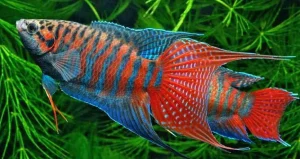
Paradise fish is a type of Gourami that originates from East Asia. It is a favorite of aquarium enthusiasts due to its appealing colors. The size of the fish varies from 2.4 to 4 inches.
Appearance: These fish stand out due to their vibrant orange and blue color. However, male fish feature brighter colors than female fish. Their standout feature is that they tend to change their color during any fight. Moreover, they can also extend their fins which appeals to fish lovers.
Behavior: The downside of keeping these fish is that they are incredibly aggressive.
Compatibility: They are very hostile in nature and kill the other bodies in the freshwater aquarium.
Therefore, to keep a peaceful environment in your tank, you need to create a balance. Aquarists can house it in a group of 4-5 female fish. However, you need to ensure that no aggressive fish enter the community. Moreover, they are not compatible with male gouramis.
Salvini Cichlid (Cichlasoma salvini)
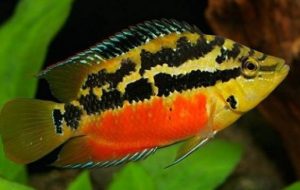
Salvini cichlids are alluring fish with a distinctive look. They originate from North America and are widespread in the rivers of Mexico. They can grow up to the size of 8 inches. However, when you keep them as your pets, they will need a natural habitat. Therefore, you will need to add plants to your water tank.
Appearance: They have an oval-shaped body with a yellowish golden color.
They have a pointed snout, and their body features two black lines at their side. When they swim, their bodies glimmer.
Behavior: They are aggressive in behavior towards other species. But they are not bold to their species.
Compatibility: They are not compatible with the fish of other species. However, they are compatible with Salvini cichlids. If you plan to keep male Salvini, I suggest you keep one male in a group of 5-6 females. You will need to maintain the ratio for that.
Furthermore, consider the size as well. Keep the same sized fish of the same specie to keep the environment peaceful.
Celestial Pearl Danio
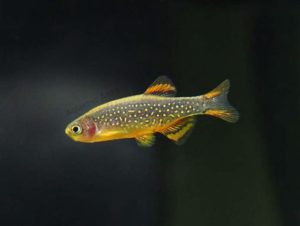
The last fish in our list originates from ponds in South East Asia. These are hardy fishes and make a great addition to community tanks.
Appearance: These are tiny fishes that can reach a length of 1 inch at the maximum. They have beautiful white spots all over their body with orange and red fins. Males in this species have more vivid colours as compared to females who appear paler. While the males are thin, females look rounder in shape.
Behaviour: Celestial Pearl Danios are timid and shy. They can co-reside peacefully with other fishes of the same nature and size.
Compatibility: You can house these fishes with small communities like tetras, killifish, guppies and corydoras. They are bottom dwellers, so keeping other fishes that can occupy the different levels in the tank will be a good idea.
Wrapping Up
If you are beginning with the hobby of fish keeping, then it is recommended to add a few fish at a time which will allow you to understand how to take care of such species.
We hope this post was helpful.
